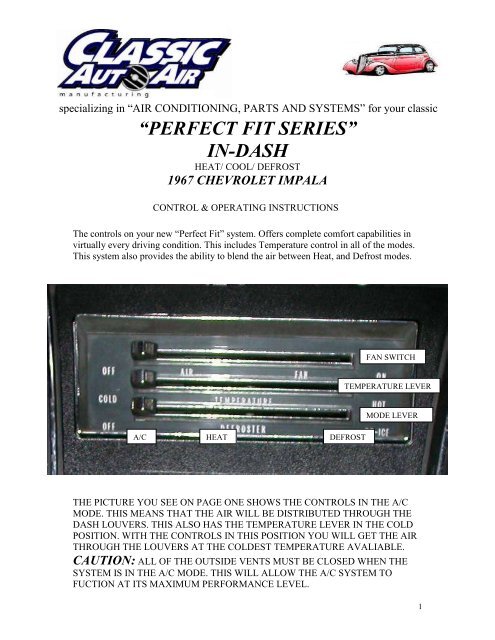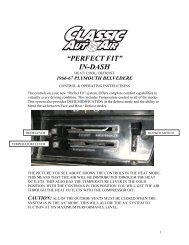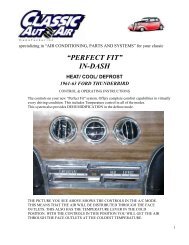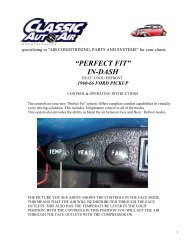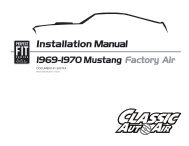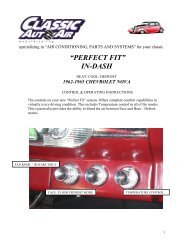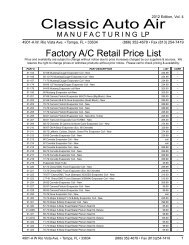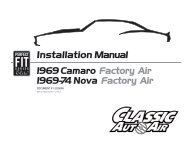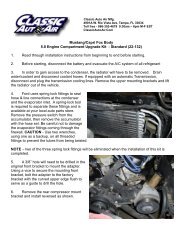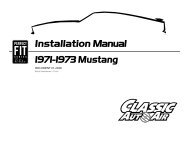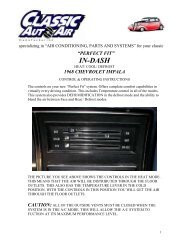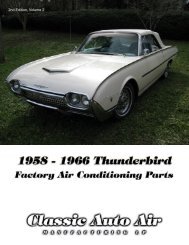1967 Chevy Sedan-Impala - Classic Auto Air
1967 Chevy Sedan-Impala - Classic Auto Air
1967 Chevy Sedan-Impala - Classic Auto Air
You also want an ePaper? Increase the reach of your titles
YUMPU automatically turns print PDFs into web optimized ePapers that Google loves.
specializing in “AIR CONDITIONING, PARTS AND SYSTEMS” for your classic<br />
vehicle<br />
“PERFECT FIT SERIES”<br />
IN-DASH<br />
HEAT/ COOL/ DEFROST<br />
<strong>1967</strong> CHEVROLET IMPALA<br />
CONTROL & OPERATING INSTRUCTIONS<br />
The controls on your new “Perfect Fit” system. Offers complete comfort capabilities in<br />
virtually every driving condition. This includes Temperature control in all of the modes.<br />
This system also provides the ability to blend the air between Heat, and Defrost modes.<br />
FAN SWITCH<br />
TEMPERATURE LEVER<br />
A/C HEAT DEFROST<br />
MODE LEVER<br />
THE PICTURE YOU SEE ON PAGE ONE SHOWS THE CONTROLS IN THE A/C<br />
MODE. THIS MEANS THAT THE AIR WILL BE DISTRIBUTED THROUGH THE<br />
DASH LOUVERS. THIS ALSO HAS THE TEMPERATURE LEVER IN THE COLD<br />
POSITION. WITH THE CONTROLS IN THIS POSITION YOU WILL GET THE AIR<br />
THROUGH THE LOUVERS AT THE COLDEST TEMPERATURE AVALIABLE.<br />
CAUTION: ALL OF THE OUTSIDE VENTS MUST BE CLOSED WHEN THE<br />
SYSTEM IS IN THE A/C MODE. THIS WILL ALLOW THE A/C SYSTEM TO<br />
FUCTION AT ITS MAXIMUM PERFORMANCE LEVEL.<br />
1
THE FOLLOWING SUMMARY WILL DESCRIBE EACH OF THE CONTROL<br />
LEVERS FUNCTION.<br />
FAN SPEED SWITCH: There are 3 speeds plus Off. When the switch is in the off<br />
position it will disconnect the 12V power to the Blower Motor and the A/C Clutch. This<br />
will shut down the entire system. When the switch is moved to any of the blower speeds<br />
1,2 or 3 there is 12V supplied to the Micro-Switch which is mounted on the defrost air<br />
housing.<br />
FACE / FLOOR / DEFROST MODE: When the BOTTOM lever is pushed<br />
towards the RIGHT, it will BLEND the air between the FACE outlets and the FLOOR<br />
dumps. As the lever is moved further to the RIGHT position the air will BLEND between<br />
the floor dumps and defrost outlets. When the lever is in the Defrost position the A/C<br />
Compressor is activated and provides Dehumidification.<br />
TEMPERATURE CONTROL: The temperature lever as shown is in the<br />
COLDEST temperature position. As the lever is pushed to the right the temperature of<br />
the discharged air will rise to the HOTTEST point.<br />
Note: The temperature lever will function in any of the modes.<br />
2
specializing in “AIR CONDITIONING, PARTS AND SYSTEMS” for your classic<br />
vehicle<br />
INSTALLATION INSTRUCTIONS<br />
<strong>1967</strong> CHEVROLET IMPALA<br />
Congratulations!! You have just purchased the highest quality, best performing A/C<br />
system ever designed for you <strong>Classic</strong> Car. To obtain the high level of performance and<br />
dependability our systems are known for, pay close attention to the following<br />
instructions.<br />
Before beginning the installation check the box for the correct components.<br />
Evaporator<br />
Heater Duct Assembly<br />
Inlet <strong>Air</strong> Block Off Assembly<br />
Firewall Block Off Assembly<br />
Flex hose 2” dia. (4) 2’, (1) 4’, (1) 52”<br />
Sack Kit Hardware (2)<br />
Sack Kit Control<br />
Glove box<br />
IMPORTANT INFORMATION<br />
1. Before starting, read the instructions carefully and follow proper sequence.<br />
2. Check condition of engine mounts. Excessive engine movement can damage<br />
hoses to A/C, heater, radiator, transcooler, and power steering systems.<br />
3. Before starting, check vehicle interior electrical functions. i.e. interior lights,<br />
radio, horn, etc. When ready to start installation, disconnect battery.<br />
4. Fittings. Use one or two drops of lubricant on O’rings, threads and rear of bump<br />
for O’ring where female nut rides. Do not use thread tape or sealants.<br />
5. Always use two wrenches to tighten fittings. Try holding in one hand while<br />
squeezing together while other hand holds fitting in position.<br />
6. Shaft seals in a small percentage of compressors will require as much as 3-4<br />
hours run time to become leak free.<br />
7. Compressors supplied in our complete systems are filled with proper amount of<br />
oil.<br />
8. Compressor requires technician to hand turn 15-20 revolutions before and after<br />
charging with liquid from a charging station before running system.<br />
Compressors with damaged reed valves cannot be warranted.<br />
9. Should you have any technical questions, or are suspect of missing, or defective<br />
parts, call us immediately. Our knowledgeable staff will be glad to assist you.<br />
3
YOU CAN NOW BEGIN THE INSTALLATION<br />
Remove Glove box door, glove box, retain glove box<br />
and original hardware. Remove radio, set aside for<br />
reinstall. Retain original hardware.<br />
Remove screws from the fresh air door control<br />
bracket. Retain original hardware.<br />
Let cable assembly drop the floor.<br />
Disconnect battery and remove.<br />
Remove the hood.<br />
Retain original hardware.<br />
The bolts for the inner fender liner must be removed and retained. Remove the passenger’s<br />
front wheel.<br />
BOLTS INNER FENDER<br />
BOLTS AROUND<br />
WHEEL OPENING.<br />
BOLTS ON TOP OF<br />
FENDER LINER<br />
4
Carefully remove the following components as shown in the pictures below.<br />
Retain all components and original hardware.<br />
LIGHT BEZEL<br />
TURN SIGNAL ASSEMBLY<br />
CORNER BUMPER ASSEMBLY<br />
Remove the corner bumper assembly. The<br />
bolts are located as shown in the picture.<br />
BOLTS<br />
The body trim needs to be removed along the lower side as shown.<br />
BODY TRIM<br />
Carefully snap off the trim. Caution: do not scratch paint.<br />
5
After removing trim the<br />
retaining bracket next to the<br />
front wheel well needs to be<br />
removed. Retain the bracket and<br />
original hardware.<br />
RETAINING BRACKET<br />
There are bolts and spacers<br />
located under the fender that<br />
fasten the fender. Remove these<br />
and retain hardware.<br />
BOLTS AND SPACERS<br />
CAUTION: FENDER IS INSTALLED WITH SPACERS FROM THE FACTORY.<br />
MAKE NOTE OF QUANTITY FOR REINSTALLATION.<br />
Remove the (2) body bolts located next to<br />
the hood hinge.<br />
Retain bolts and spacers.<br />
BOLT<br />
BOLT<br />
Remove the body bolt behind the passenger<br />
door. Retain the original hardware and spacers.<br />
Remove and retain the (4) bolts on the<br />
radiator bulkhead.<br />
6
Remove fender and set aside for later<br />
reinstallation.<br />
Remove the blower and housing assembly. Discard and retain<br />
(2) screws that are above and below the blower motor.<br />
Locate the air inlet block off from the kit.<br />
Using the original hardware attach over inlet<br />
hole.<br />
Reinstall the fender, body trim,<br />
corner bumper assembly, turn<br />
signal assembly and the light<br />
bezel.<br />
7
DRAIN COOLANT FROM RADIATOR.<br />
Remove Heater hoses from heater coil at<br />
firewall.<br />
Heater hoses<br />
Disconnect electrical plug at<br />
resistor.<br />
Pull heater assembly away<br />
from the firewall.<br />
Disconnect the (2) control<br />
cables from the box. Discard<br />
the heater and the mounting<br />
hardware.<br />
Locate wire assembly that plugged into the original blower switch. Cut all but the brown<br />
wire as far back as you can.<br />
Cut the brown wire at the plug. And attach a male insulated spade connector.<br />
8
Remove the (4) screws along the top of the instrument<br />
bezel. Retain hardware.<br />
Carefully snap the bottom of the bezel away from the<br />
instrument panel.<br />
Remove the (4) screws that attach the<br />
control head mounting bracket. Retain<br />
original hardware.<br />
Remove control head. Retain original<br />
hardware.<br />
CONTROL MODIFICATIONS:<br />
Locate the original control assembly. Remove and discard following components. Retain all<br />
original hardware.<br />
(1) Original Blower Switch<br />
(2) Heat Cable<br />
(3) Temp Cable<br />
Attach Blower Switch assembly on to control<br />
head using the original hardware.<br />
As shown in picture it is necessary to rotate the assembly and slide<br />
over the screw that will be under the switch. This screw will need to<br />
be tightened with a wrench.<br />
9
Locate in the control sack kit the Connecting Wire<br />
and (1) 3/16” push nut.<br />
Hook the wire through blower switch hole in the<br />
lever and then over the Control Lever. Use push<br />
nut to hold the connecting wire.<br />
7/8”<br />
Rotate the control head upside down.<br />
Carefully mark the control lever as shown. Carefully<br />
drill (1) hole 5/64” diameter.<br />
Caution: hole must be 5/64” diameter. Do<br />
not enlarge hole.<br />
DRILL<br />
5/64”<br />
1/8”<br />
13/16”<br />
Locate in the control sack kit the<br />
( SHORT) Heat / Defrost control cable,<br />
( LONG) Temperature control cable,<br />
( 2) 3/16” push nuts, and (2) Cable Clips.<br />
Attach temperature control cable and<br />
clip to the center lever arm using<br />
original screw and 3/16” push nut.<br />
NOTE: The cable sleeve is located<br />
13/16” from the control head as shown.<br />
2 1/8”<br />
Attach Heat / Defrost cable to control<br />
lever on the bottom. Install cable<br />
through the previously drilled hole as<br />
shown. Using (1) cable clip, and the<br />
original screw.<br />
NOTE: The cable sleeve is located 2 1/8” from the cable clip as shown.<br />
10
Attach Wire Harness supplied in kit to the blower switch.<br />
REFER TO THE WIRING DRAWING ON LAST PAGE FOR PROPER CONNECTIONS.<br />
Reinstall control head, mounting bracket, and instrument bezel, using original hardware.<br />
Locate in the hardware sack kit the heater<br />
distribution assembly, and (2) #10 x ¾”<br />
screws.<br />
Attach assembly above the center of the<br />
doghouse just where the firewall meets the<br />
dog house. Pre drill 1/8” diameter hole.<br />
Attach assembly using the #10 screws.<br />
Remove the original defrost distribution assembly. Discard the assembly and original hardware.<br />
Locate in the hardware sack kit (2) defrost diffusers.<br />
Attach to the drivers and passengers outlets as shown.<br />
The s-clips attach to the metal lip.<br />
S-CLIPS (2)<br />
11
Locate on the last page of the instructions<br />
a template. Cut out as shown.<br />
Tape the template to the firewall as<br />
shown in the picture.<br />
Notch the corner of the heater opening,<br />
and drill (2) 7/8” diametre holes.<br />
Using a pair of pliers flatten the lip of the opening<br />
under the 7/8” holes.<br />
Locate in the hardwae sack kit (2) heater bulkheads.<br />
Insert bulkheads from the inside of the car. Attach<br />
with nuts, tighten nuts.<br />
Locate the (2) 5/8” diameter heater hoses provided in kit.<br />
Locate (2) worm gear clamps from the hardware sack kit.<br />
The longest heater hose attaches to the fitting on right<br />
using (1) of the worm gear supplied.<br />
The shortest heater hose attaches to the fitting on left using<br />
(1) of the worm gear clamps.<br />
12
Locate the evaporator, (1) 1ft of 2” diameter flex duct, (1) 2ft. of 2” diameter flex duct, and (2)<br />
ty-raps.<br />
Place unit on bench and attach the 2ft duct to the left hose adaptor using (1) ty-rap.<br />
Attach the 1ft duct to the right hose adaptor using (1) ty-rap. As shown in picture on next page.<br />
The next step is to install the evaporator into the car. The picture to<br />
the right shows the unit from the front. Note the 2ft duct lays over the<br />
top of the unit as it is installed.<br />
Lift unit up and behind the instrument panel. The picture on next page<br />
shows the engine side of the firwall. The (2) studs insert into the<br />
original heater mounting holes. Attach using (2) ¼”-20 flange nuts<br />
provided in the hardware sack kit.<br />
2 ft flex duct<br />
1 ft flex duct<br />
Attach th flex duct from the heater outlets to the<br />
distribution assembly. As shown.<br />
Locate in the kit (1) 2ft 2” diameter flex hose and<br />
(1) 2” diameter flex hose.<br />
Attach the 2ft hose from the left defrost outlet to<br />
the drivers side defrost diffuser. Attach to diffusser<br />
using (1) #8 x 3/8” pan head screw.<br />
1ft DUCT HOSE<br />
Attach the 1ft hose from the right defrost outlet to<br />
the passenger side defrost diffuser. Attach to<br />
diffusser using (1) #8 x 3/8” pan head screw.<br />
2FT DUCT HOSE<br />
13
Route the temperature control cable along the firewall and out the large hole as shown in the<br />
picture below.<br />
Locate in the hardware sack kit (1) #10 x ¾” tek screw.<br />
Located under the glove box opening the front support<br />
bracket. Using the #10 screw attach to the bottom of the<br />
instrument panel.<br />
Route wire harness across the unit and plug the 4 pin<br />
connector into the blower motor.<br />
Attach the (2) blue wires from the harness to the top of the<br />
thermostat. The blue wire without the connector, route<br />
over the top of the unit and out next to the temp cable.<br />
Locate (1) #10 tek screw from the hardware sack kit.<br />
Attach ground wire from the motor plug to the body.<br />
Locate the white plug with (2) wires that is attached to the<br />
harness. Plug this into the micro switch on the side of the<br />
unit.<br />
Attach the heat/ defrost cable to the unit as shown.<br />
Insert the cable wire into the cam and attach the cable<br />
housing to the bracket using (1) #8 x 3/8 pan head screw.<br />
Tighten securly.<br />
14
Route the heater hoses that were attached to the<br />
bulkheads, and attach to the heater fittings on the front<br />
of the unit.<br />
Attach using (2) worm gear clamps provided.<br />
Locate the firewall blockoff, (1) ¼”-20 x 5/8 hex head screw, (3) ¼”-20 flange nuts, and (3)<br />
#10 x ¾ “ tek screws.<br />
Insert the Blue clutch wire and the Temp control cable through the ½” plastic grommet in the<br />
firewall blockoff.<br />
Slide the blockoff over the suction tube, heater bulkheads, and insert the liquid tube through the<br />
hole in the bulkhead.<br />
The blockoff will slide over the studs at the bottom of the mounting bracket.<br />
#10 SCREW<br />
#10 SCREWS<br />
¼” – 20 X 5/8<br />
SCREW & NUT<br />
STUDS<br />
Attach blockoff using the flange nuts at bottom, (3) #10 tek screws across the top, and (1) ¼”<br />
bolt and nut from the inside of firewall on the bottom left. Seal around a/c hoses using the<br />
insulation tape supplied.<br />
Locate in the hardware sack kit (1) single face outlet and (2)<br />
#10 x ¾” tek screws.<br />
Attach the housing under the dash on the passenger side.<br />
Attach housing to the right of the glove box door.<br />
Insert louver assembly into housing.<br />
15
#10 TEK SCREWS<br />
Locate the center face distribution hose adaptor.<br />
Attach adapter under center of instrument panel<br />
using (2) #10 tek screws.<br />
Locate Center Louver Bezel Assembly<br />
and (2) #8 x 3/8” pan head screws.<br />
Attach bezel assembly over hose adaptor<br />
and fasten with (2) #8 screws. (2) on<br />
bottom.<br />
Locate in the hardware sack kit (1) single face outlet and<br />
(2) #10 x ¾” tek screws.<br />
Attach the housing under the dash on the drivers side.<br />
Attach housing to the right of the parking brake release<br />
handle.<br />
Insert louver assembly into housing.<br />
Locate (4) pieces of the 2” flex<br />
duct from the unit box.<br />
(1) 4ft, (1) 3ft cut the duct to 32”,<br />
(1) 3ft, and (1) 2ft.<br />
DRIVERS CENTER LT. CENTER RT. PASSENGER<br />
4FT 32” 3FT 2FT<br />
Attach the hoses as shown and<br />
route to the dash louvers.<br />
Reattach the fresh air door cable using original hardware.<br />
16
Locate 6” piece of drain tube.<br />
Just to the right of the unit below the drain tube<br />
nipple. Drill (1) 13/16” diameter hole and insert the<br />
drain tube.<br />
DRAIN NIPPLE<br />
NOTE: HOLE MUST BE BELOW THE DRAIN<br />
TUBE NIPPLE TO ALLOW PROPER<br />
CONDENSATION DRAIN.<br />
Locate the glove box door and carefully locate a<br />
line 2 ¾” from the edge of the door back.<br />
2 ¾”<br />
Locate the glove box from the unit box and (3)<br />
#10 x ¾” tek screws.<br />
Attach glove box to door with top edge along the line<br />
previously marked. Use the (3) screws supplied.<br />
Reinstall glove box door using original hardware.<br />
Caution: Carefully check under the Instrument Panel for all cables, electrical harness, or Flex<br />
hoses that might interfere with the safe operation of the vehicle.<br />
17
Locate the Water Valve and (3) worm gear clamps.<br />
Attach the Temperature cable to the water valve using the<br />
cable clip supplied on the water valve.<br />
Supply line from the engine is attached to the left heater<br />
hookup tube. Cut 6” off end of the return line and install<br />
the water valve using (3) worn gear clamps as shown<br />
above.<br />
Note: It is recommended that you replace heater hoses<br />
from the engine to the hookup tubes.<br />
Installation of the interior components is complete. We will now install the<br />
under hood portion of the system.<br />
5/8”<br />
There needs to be a 1” hole for the<br />
discharge tube to come through the<br />
radiator support.<br />
Locate on the passenger side of the<br />
radiator support. The center of the hole to<br />
be drilled. Drill a 1” hole to the<br />
dimensions as shown.<br />
6 7/8”<br />
Locate the Receiver Drier, Drier Mounting Bracket,<br />
Aluminum Liquid tube, (2) #6 o-rings, and (2)<br />
#10 x 3/8” hex head screws.<br />
Install the Receiver drier to the condenser as to<br />
allow the Liquid Tube to attach as shown.<br />
Install a few drops of mineral oil to the o-ring<br />
fittings, and secure.<br />
18
Locate the Condenser, (2) right condenser mounting brackets<br />
(short), and (4) #10 x 3/8” hex head screws.<br />
Attach (1) bracket to the condenser 3rd hole from the top as<br />
shown.<br />
Attach the other bracket 4 th hole from the bottom as shown<br />
Remove and retain the (5) bolts that attach the hood latch<br />
assembly.<br />
Remove hood latch and set aside.<br />
SHROUD BOLTS<br />
Loosen the radiator shroud bolts. These<br />
bolts are located on both sides of the<br />
radiator opening.<br />
Slide condenser down in front of radiator.<br />
Insert the brackets between the shroud and<br />
the radiator bulkhead.<br />
Locate the Condenser, (1) left condenser mounting<br />
bracket (long), and (2) #10 x 3/8” hex head screws.<br />
Slide bracket between shroud and the radiator<br />
bulkhead. Attach (1) bracket to the condenser 4th<br />
hole from the bottom as shown. Attach the bracket<br />
to the condenser using the #10 screws.<br />
19
Locate the #8 discharge tube, and (1)<br />
#8 o-ring.<br />
Route tube through the hole and attach<br />
to condenser using the o-ring and a few<br />
drops of mineral oil.<br />
Insert top bracket between shroud and the radiator bulkhead.<br />
Attach bracket to the condenser in the top hole as shown.<br />
Attach the bracket to the condenser using the #10 screws.<br />
Slide condenser assembly to the left and up and down so that<br />
the tube comes through the hole in the center.<br />
Tighten shroud to clamp brackets to radiator bulkhead.<br />
Locate the #6 liquid tube and (1) #6 o-ring.<br />
Loosely attach tube to drier. Using the<br />
other end locate and drill (1) hole 11/16”<br />
diameter.<br />
Insert the bulkhead fitting through the hole and<br />
attach using the nut provided.<br />
Tighten fitting and bulkhead securely.<br />
Locate Hi-Low pressure switch ,electrical boot and<br />
attach to top of the receiver drier using a few drops<br />
of mineral oil. Route wires through the hole along<br />
the discharge tube.<br />
Reinstall hood latch assembly using original hardware.<br />
20
INSTALL THE COMPRESSOR ADAPTER KIT AND COMPRESSOR AT THIS<br />
TIME PER THE MANUFACTURERS DIRECTIONS.<br />
NOTE: THIS INSTALL IS CORRECT FOR A 350CID V8 ENGINE, WITH<br />
ALTERNATOR ON DRIVERS SIDE OF VEHICLE.<br />
IF YOUR VEHICLE IS EQUIPTED WITH A DIFFERENT ENGINE PACKAGE<br />
IT WILL BE NECESSARY TO ROUTE THE HOSES DIFFERENT<br />
Locate the #10 refrigerant hose.<br />
Attach 90 deg. end without the service<br />
port to #10 fitting at the firewall. Attach<br />
using (1) #10 o-ring and a few drops of<br />
mineral oil.<br />
Route the hose inside the fender forward<br />
and out between the battery and fender<br />
liner.<br />
Attach the end with the service fitting to<br />
the compressor using (1) #10 o-ring and a<br />
few drops of mineral oil.<br />
Tighten securely.<br />
Locate the liquid hose, and (2) #6<br />
o-rings.<br />
Attach the 90 deg. fitting with the male<br />
threads to the firewall. Use (1) #6 o-ring<br />
and a few drops of mineral oil.<br />
Route hose inside the fender forward around the battery and connect the end with<br />
the 45deg. fitting to the liquid fitting on the radiator core support.<br />
Attach using #6 o-ring and a few drops of mineral oil. Tighten securely.<br />
Locate the #8 discharge hose and (2) #8 o-rings.<br />
Attach the end with the straight fitting to the discharge tube from the condenser using (1)<br />
#8 o-ring and a few drops of mineral oil.<br />
Attach #8 refrigerant hose with service port end to the compressor using (1) #8 o-ring and a<br />
few drops of mineral oil. Tighten securely.<br />
21
Reinstall hood, battery tray and battery, using original hardware. Refill radiator.<br />
Carefully check the hood alignment for proper fit.<br />
THE ENGINE COMPARTMENT OF YOUR SYSTEM IS COMPLETE.<br />
THE UNIT IS READY FOR EVACUATION AND CHARGING.<br />
THIS SHOULD BE DONE BY A QUALIFIED AND CERTIFIED AIR<br />
CONDITIONING TECHNICIAN.<br />
NOTE: COMPRESSOR IS SUPPLIED WITH THE<br />
CORRECT OIL CHARGE. DO NOT ADD OIL TO SYSTEM.<br />
134A SYSTEMS 24 oz OF REFRIGERANT<br />
Recommend that power fuse is 25 amp minimum<br />
Congratulations you have completed the install of your<br />
CLASSIC AUTO AIR “PERFECT FIT SERIES” system.<br />
22
IMPORTANT<br />
CAUTION: WATER VALVE MUST BE INSTALLED PER<br />
THE INSTRUCTIONS.<br />
<strong>Classic</strong> <strong>Auto</strong> <strong>Air</strong> has done extensive testing on the correct method to install the water valve in order to get a<br />
repeatable and progressive temperature control.<br />
Locate the bottom connection from the evaporator/heater unit off of the firewall and attach a 6” piece of<br />
5/8” dia. heater hose with the supplied hose clamp. Next attach the inlet side of the water valve using<br />
another supplied hose clamp, (make sure the arrow on the water valve points toward the engine) Attach a<br />
heater hose from the outlet side of the water valve and route to the connection on the water pump.<br />
NOTE: WATER VALVE = WATER PUMP<br />
FROM HEATER CORE<br />
TO WATER PUMP<br />
COOLANT FLOW<br />
CAUTION: WATER VALVE MUST BE INSTALLED ON HEATER LINE ROUTED TO<br />
WATER PUMP.<br />
NOTE: COMPRESSOR PURCHASED WITH KIT IS<br />
SUPPLIED WITH THE CORRECT OIL CHARGE. DO NOT<br />
ADD OIL TO SYSTEM.<br />
134A SYSTEMS 24 oz OF REFRIGERANT<br />
Recommend that power fuse is 25amp minimum<br />
23


